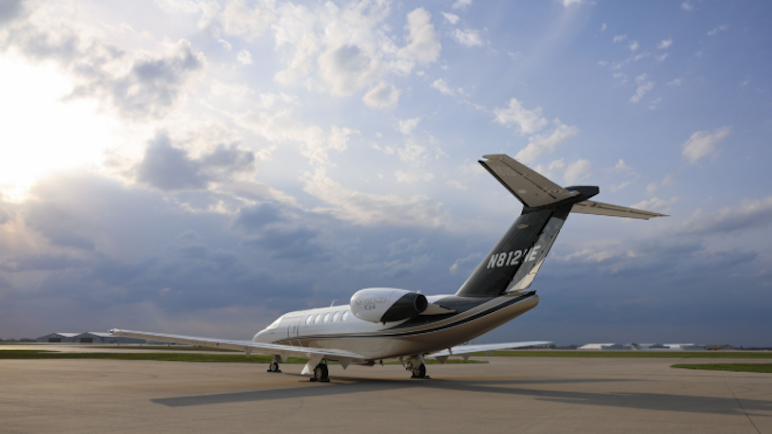

Last month VistaJet came up with an innovative short-term solution to the COVID-19 Coronavirus crisis. The answer was to offer its fleet of silver and red Bombardier private jets on short-term leases, starting at just one month. The leases include crews and even flight hours. We caught up with Chief Commercial Officer Ian Moore to get the details.
What was the thinking behind VistaJet Dynamic Lease?
Dynamic Jet Lease is the ideal short-term private jet lease for businesses and private individuals alike, especially during times of uncertainty or when quick decisions need to be made. The program is also an excellent solution for people who don’t want to use their own aircraft overseas at the moment or don’t want to charter other people’s aircraft
While 50 hours are included, can you give us a ballpark on the starting point from a price standpoint?
The starting point is the Challenger 350, which is a super-midsize aircraft. The monthly cost is $445,000 plus a $50,000 deposit. The deposit is used to offset additional charges, calculated at the end of each month against actual usage. Additional charges include, but are not limited to, fuel surcharges, landing and handling costs.
Once the lease is signed, how does arranging flights work?
The lessor would have access to our 24/7 member service team, who will handle all bookings.
How does it work with the pilots? Where do they stay when not flying?
In an approved hotel near the airport they’ve just landed in and hotel by the home base on their days off.
What if a pilot gets sick? What if there’s a mechanical?
If the aircraft is unavailable due to technical issues or pilot sickness for 96 consecutive hours, VistaJet will provide a replacement aircraft or pilot. In the meantime, we would source other recovery options at the client’s cost.
Can you talk us through the details? What’s included or an extra charge?
The lease includes complimentary first flight, up to 50 block hours per month, dedicated aircraft and crew, our standard service areas, maintenance included, oils, greases, hydraulic fluids, any import or export charges, permits and permissions and the cost of local catering equivalent to standard European catering but exclusive handling, landing fees, ATC navigation charges and fuel up to 135 US cents per gallon.
Main extra charges include fuel surcharge, landing and handling costs, de-icing, WiFi, hours flown in excess of 50 hours per month, and an extra set of crew if required
I assume this is under Part 91 in the U.S. – so what does that mean in terms of crew limits, rest time, and so forth?
We are adhering to the more stringent Part 135 rules, and subject to Part 135 technical operations specifications and compliance.
Can you highlight any differences from using a leased aircraft compared to one you own, a fractional share, jet card or on-demand charter?
Compared to owning your own aircraft, our program is governed under commercial regulations. Aside from the price, short term commitment and global infrastructure, another advantage is VistaJet offers replacement aircraft and crew should the aircraft be grounded due to technical issues.
Versus fractional share, the aircraft is dedicated entirely to you for the duration of the lease. There’s no asset purchase, and you have dedicated crews.
In comparison to jet cards, again, you get the aircraft entirely dedicated to you with dedicated crews.
If you were going to look at charter solutions, again, you are getting a fixed price and guaranteed availability, plus you are getting access to the VistaJet fleet, which I think most readers will agree is the gold standard in our industry.
What rules and laws govern the lease?
The program is governed under commercial regulations. All lights are undertaken pursuant to all applicable rules and regulations. The contract itself uses standard choice of law provision. English law for VistaJet Limited and New York State for VistaJet in the U.S.
Are there any constraints on base airport, aside from having a runway long enough for the type?
The top consideration is safety. VistaJet is responsible for all flight safety determinations. Because the Service Area includes the entire world, there are a number of factors that play into airport approvals, which include, but are not limited to, fire safety, customs, paved versus gravel, war risk, the sufficiency of ground systems and infrastructure, and so on. Also, we need to consider customs, depending on the country of the base. That said, the goal is to have the aircraft based at the airport you want. If something comes up, obviously we talk through it and find the best option.
While you highlighted four aircraft types available, are others available as well?
You’re correct. It’s limited to the Challenger 350, Challenger 605, Challenger 850, Global 6000. I think if you look at typical needs, between these types we have all the bases covered.
How does where you are flying impact price? Do different aircraft have different service areas?
Landing and handling charges differ from airport to airport, and the great news is the service area is the same for all aircraft. If you look at typical fractional programs, that’s not the case.
Anything else you would add?
We’re very excited about this, and while we have limited availability, we believe for certain people, it will really be a unique option without anything else comparable that we’ve seen. Ever since launching in 2004, VistaJet has placed the highest attention on operational and flight safety and to date has completed over 174,000 flights globally, having safely flown over 436,000 passengers to more than 1,900 airports worldwide. We have been on the leading edge when it comes to safety and operational excellence. Our flight crews receive continued training, and they are full-time employees.